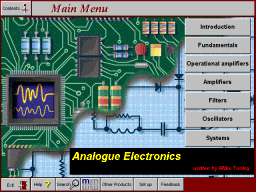

1:10-2:00 Stocker 107
Professors: Dr. Robert Curtis and Dr. Janusz Starzyk Winter Quarter, 2000
Text
C. Jaeger, Microelectronic Circuit
Design (Introduction to Electronics)
McGraw Hill 1996.
Reference
Roger Thomas Howe, Charles
Sodini (Contributor), Microelectronics : An Integrated Approach (Prentice
Hall Electronic and Vlsi Series), 1996.
Course outline
Introduction to Microelectronics.
Introduction.
Signals, notation.
Semiconductor Physics and IC Technology.
Pure
Semiconductors. Generation, Recombination, and Thermal Equilibrium. Doping.
Carrier
Transport. Silicon Integrated Circuit Technology.
pn Junction and MOS Electrostatics.
Applied
Electrostatics. Carrier Concentration and Potential in Thermal Equilibrium.
The
PN Junction in Thermal Equilibrium. The PN Junction Under Reverse Bias.
Depletion
Capacitance.
The pn Junction Diode.
pn
Diode Circuit Symbol and Terminal Characteristics. Integrated Circuit pn
Diodes.
The
pn Junction Diode: A First Pass. pn Junction Diode Circuit Models. SPICE
Model
of
the pn Junction Diode. Device Physics of the pn Junction Diode: Non-Equilibrium
Minority
Carrier Recombination. The Continuity Equation. Diode Applications.
The MOS Field-Effect Transistor.
Introduction.
Device Physics of MOSFET: Drain Current and Channel Charge.
MOSFET
Device Physics: A First Pass. MOSFET Device Physics: the Gradual
Channel
Approximation. MOSFET Circuit Models. Level I DC Model 35.
The Bipolar Junction Transistor.
Introduction.
Bipolar Junction Transistor Physics: A First Pass. Reverse Active and
Saturation
Operating Regions. The Ebers-Moll Equations. Small-Signal Model of the
npn
BJT. BJT Device Physics. Lateral pnp Bipolar Transistor. SPICE Models for
Bipolar
Junction Transistors.
Single-State Bipolar/MOS Transistor Amplifiers.
General
Amplifier Concepts. Common-Emitter Amplifier-Introduction.
Common-Source
Amplifier-Introduction. Current Source Supplies. Common-Source
Amplifier
with Current Source Supply. Common-Emitter Amplifier with Current
Source
Supply. Improved Transconductance Amplifier with Emitter Degeneracy
Resistor.
Common-Base/Gate Amplifier.
Office hours and contact information
Dr. Starzyk - Tuesday and Thursday
2-3 p.m.; other hours by appointment.
starzyk@bobcat.ent.ohiou.edu
http://www.ent.ohiou.edu/~starzyk
Office location - Stocker 347.
Dr. Curtis - Monday, Wednesday,
and Friday 11 a.m. -12 p.m.
rcurtis@bobcat.ent.ohiou.edu
http://www.ent.ohiou.edu/~rcurtis
Office location - Stocker 313.
Grading
Grades will be based on the following;
Each homework problem is worth 1 point. Full credit
is given even if the answer is wrong. If the work is not complete, or if
only a small part of the problem was attempted, the grade will be 1/2 or
0 based on how much is handed in. Grading of computer problems is similar,
except that the maximum grade is up to 5 points, and these ARE graded on
merit.
The total grade is the sum of homework and computer points,
THE BEST midterm, and the final exam. This score is compared
with other students' scores, and a letter grade is assigned. Note that
neglecting the homework can lower your grade a great deal!
Examinations
All examinations are closed
books and notes. Students may have one sheet with formulas as a help during
each exam. No make-ups are allowed for tests except in accordance
with University policy for excused absences.
Withdrawal
A student may withdraw from class at his discretion up to and including the first 21 days of the quarter.
Academic Conduct
Cheating on examinations, submitting work of other students as your own, or plagiarism in any form will result in penalties ranging from an F on the assignment or exam to expulsion from the university, depending on the seriousness of the offense.